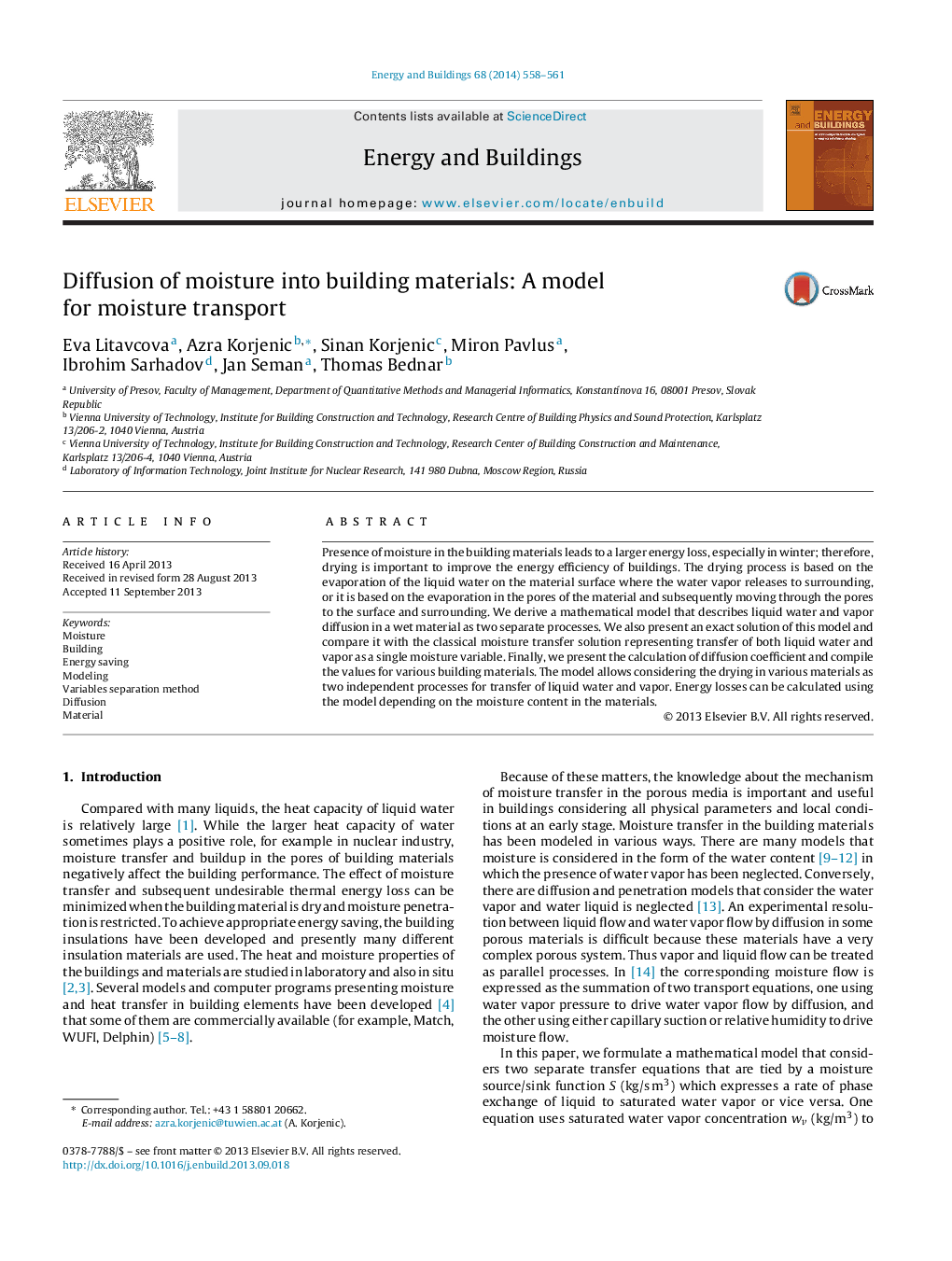| کد مقاله | کد نشریه | سال انتشار | مقاله انگلیسی | نسخه تمام متن |
|---|---|---|---|---|
| 10286043 | 504067 | 2014 | 4 صفحه PDF | دانلود رایگان |
عنوان انگلیسی مقاله ISI
Diffusion of moisture into building materials: A model for moisture transport
ترجمه فارسی عنوان
انتشار رطوبت در مصالح ساختمانی: یک مدل برای انتقال رطوبت
دانلود مقاله + سفارش ترجمه
دانلود مقاله ISI انگلیسی
رایگان برای ایرانیان
کلمات کلیدی
مرطوب، ساختمان، ذخیره انرژی، مدل سازی، روش جداسازی متغیرها، نفوذ، مواد
ترجمه چکیده
وجود رطوبت در مصالح ساختمانی منجر به از دست دادن انرژی بیشتر، به خصوص در زمستان؛ بنابراین خشک کردن برای بهبود بهره وری انرژی ساختمان ها مهم است. فرایند خشک کردن بر اساس تبخیر آب مایع بر روی سطح مواد است که بخار آب به محیط اطراف منتقل می شود و یا بر اساس تبخیر در منافذ مواد است و سپس از طریق منافذ به سطح و اطراف حرکت می کند. ما یک مدل ریاضی را ارائه می دهیم که انتشار مایع آب و بخار را در مواد مرطوب به عنوان دو فرآیند جداگانه توصیف می کند. ما همچنین یک راه حل دقیق از این مدل را ارائه می دهیم و آن را با راه حل انتقال رطوبت کلاسیک نشان می دهیم که انتقال آب و بخار را به عنوان یک متغیر رطوبت واحد را مقایسه می کند. در نهایت، ما محاسبه ضریب انتشار و ارائه مقادیر مختلف مصالح ساختمانی را ارائه می دهیم. این مدل امکان بررسی خشک شدن مواد مختلف را به عنوان دو فرایند مستقل برای انتقال آب مایع و بخار می دهد. از دست دادن انرژی می توان با استفاده از مدل بسته به رطوبت موجود در مواد محاسبه کرد.
موضوعات مرتبط
مهندسی و علوم پایه
مهندسی انرژی
انرژی های تجدید پذیر، توسعه پایدار و محیط زیست
چکیده انگلیسی
Presence of moisture in the building materials leads to a larger energy loss, especially in winter; therefore, drying is important to improve the energy efficiency of buildings. The drying process is based on the evaporation of the liquid water on the material surface where the water vapor releases to surrounding, or it is based on the evaporation in the pores of the material and subsequently moving through the pores to the surface and surrounding. We derive a mathematical model that describes liquid water and vapor diffusion in a wet material as two separate processes. We also present an exact solution of this model and compare it with the classical moisture transfer solution representing transfer of both liquid water and vapor as a single moisture variable. Finally, we present the calculation of diffusion coefficient and compile the values for various building materials. The model allows considering the drying in various materials as two independent processes for transfer of liquid water and vapor. Energy losses can be calculated using the model depending on the moisture content in the materials.
ناشر
Database: Elsevier - ScienceDirect (ساینس دایرکت)
Journal: Energy and Buildings - Volume 68, Part A, January 2014, Pages 558-561
Journal: Energy and Buildings - Volume 68, Part A, January 2014, Pages 558-561
نویسندگان
Eva Litavcova, Azra Korjenic, Sinan Korjenic, Miron Pavlus, Ibrohim Sarhadov, Jan Seman, Thomas Bednar,
